One Newbies Journey: Part 1 – Planning.
About this Newb: As a kid in 70’s in NYC, chicken was a game of jumping turnstiles or riding on the back of the subway. Never saw a live chicken – only dead ones hanging in Grampa’s deli. Dad was a smoke-eater, a fireman. His escape was to take his boy’s hiking and camping in New Hampshire several times a year. That was when I decided I was a country boy living in a city boy’s body. Those mountains became mystical to me. Hard to explain – but it felt like where I was supposed to be. Thirty years later my career brought me here, and those mountains are now my home and playground. No joke – my will has my family spreading my ashes in these mountains.
My journey towards chickens, and BYC, is similar – simply a gut feeling I was meant to start a small farm, trying to feed us with healthy, homegrown food. Eggs and meat are a part of that journey. I was very, very ill. But great doctors, lots of surgeries and some new meds got me back on my feet, sort of. So – I was able to convince my reluctant wife that in addition to our gardens and honeybees, chickens made sense.
My Journey begins:
I'm and analyst and researcher by nature. I read books - both of which I highly recommend.

My research findings:
My Coop rules:
· Climate specific: can handle high winds (70mph+) and heavy snow load. Our climate gives somewhere between 6’ & 10’ of snow each winter, and usually a week or two below 0 degrees (F) – sometimes as low a -25, with wind chills of -20 to -50. We live on an exposed ridge – so most of our snow gets blown off the ridge.

· 4[ft] per chicken.
· Roosting space of 1 linear foot/ chicken, with 1 ft. clearance to walls and other roosts.
· 2x4 roosting bar, wide side up – apparently, this is better in cold weather, as the chickens feet don’t need to wrap around – allowing their underside to sit atop their feet, insulating them from frostbite.
· 1 nest box / 4 chickens.
· Food and water available inside in winter
· Lighting to work inside and extend laying season if desired, although this is a point that is not agreed upon on BYC
· Ventilation to allow humidity from chicken waste and breath
· No drafts on roosting chickens
· Waterproof (a dry chicken can handle NH’s cold, snowy winters)
· Protection from local predators (see below)
Run rules:
· The run’s purpose is predator protection – keeping predators from getting access to your flock when they are outside the coop.
· 10 [ft] / chicken
· Protect from local predators: Mink, Ermine, Long Tailed Weasel, Fisher (Fisher-cat in NH, even the name of our AA minor league baseball team), Owls, Hawks, Bald Eagle, Black snake. Then the big guns – all pictures were taken on our land, within 500 yards from the coop location:
Black bear:

Bobcat:

Coyote:

· ½” hardware cloth on the sides, top and either buried 1 ft. or a 2 ft. skirt around the entire coop to discourage digging predators.
· Water and food accessible during the day. At night, the ½” hardware cloth will keep out rodents- but black bear love bird feeders, and chicken feed – and can easily get through hardware cloth. For this reason, given bear in the area – electric fencing is recommended.
Predator Deterrence:
Electric Fencing creates a psychological deterrent. It does not provide a physical deterrent. Though I’m new to chickens, I’ve kept honeybees for several years. Bear love insect larvae – and a beehive has thousands of baby bees. Unlike poo bear – real bears like honey – but they love bugs. There is a lot more protein in the bees and larvae. I use electric netting to prevent smaller animals from getting to the beehives. More experienced beekeepers taught me that the key to deterring black bear is to actually draw them to the fence, and bait the fence to give them a shock. I use bacon tied to the netting. The bear (and my dogs) touch the bacon (and wire) with their nose or tongue - and never come back.
Electric netting does nothing to stop moose. This young female walked right through our bee yard ignoring the shock, and dragged the netting a few hundred yards. We decided to drop some trees along the game trail she used, making her take a different path. Our coop is in the same location as the beehives – so far, she hasn’t returned to this spot!

Newbie Mistakes: What I’d do differently: Coop planning, construction and chicken math.
I’m no expert – not even close. I’m 6 months in as a flock owner and I’m learning so much from the BYC crowd. Mostly – I’ve learned what I’d do differently.
I decided to get chickens about a year ago. I wanted to eat clean food – not industrial agro produced. I wanted eggs and meat. I researched everything I could via the Internet. I read blogs, news articles, homesteader and prepper websites, YouTube videos, and of course, Google brought me to BYC.
I spoke with my brother-in-law who annually raises a cow, pig, turkey and meat chickens. I looked at his coop and barn set up; Not something I could replicate- He lives on farmland that’s been in his family 300 years, while we are carving a homestead out of second growth forest and atop a mountain ridge.
So – should I have just asked him to raise another 20 chickens for me???
Nope – I wanted to DIY it. With no building experience, I learned framing on YouTube, and lay out my coop build based on material I already had on hand so I could build it as inexpensively as possible. I found windows at the dump.
The first big decision: where to get chicks, and what type. Breeders seemed concerned with appearance, and were much more expensive. I was going for function over form – eggs and meat, not appearance. Google google google… and I chose Meyer hatchery. I asked their advice on breeds. They need to be cold hardy – smaller comb and waddles. As I’m experimenting this first year – I decided to go for a variety. I wanted dual-purpose birds. So 3 hybrid Golden Buff (red sex link), 3 Buff Orpingtons, 3 New Hampshire reds, and 4 Barred Rocks. Ordered for late April delivery.
First mistake #1: I ordered chicks before having the coop finished. I gave myself 5 months. I started construction in the basement – framing the floor, sides, and roof trusses. I decided on 6’x8’= 48 [ft], or 4 [ft] per chicken. it was a mad dash to finish thanks to a very wet spring (NH has 5 seasons :Fall, Winter, Mud, Bug and summer)
Mistake #2: I should have gone bigger – 4 [ft]. is a minimum. Instead of 8x6, I should have gone 8’x10’ to permit roosting bars on 3 sides, 1’ from the wall, and a 2’ poop board under each. That would allow me a 4’ x 8’ area to stand in to clean poop boards and more room for the chickens when cold hits, wind blows and snow flies, and they don’t want to go outside.
It rained all of spring. I couldn’t pour the footings for the coop’s corners. We went from frozen solid to a muddy thaw. The chicks arrived before I started to assemble the pieces I built inside during winter. (See mistake #1 again), 4:30 a.m. the post office called to say that the chicks arrived in the mail – all healthy! They went in the brooder the same day I poured the footings. I now had a deadline. The chicks would outgrow the brooder in 6 weeks. The pressure was on.
Fortunately, the weather improved and I got the “too small coop” finished just as daytime temps got to about 70 and the chicks had feathers. Into the coop they went. The pop door was not open, as I hadn’t built a predator proof run yet. That gave me a week to finish the run before they’d be leaving the coop. Finished just in time. The run is 8’x15’ = 120 sqft. 10 sqft/chicken, plus and additional 48[ft] underneath the coop which is elevated 2’ above the ground.
Mistake #3. 10 sqft is a minimum per chicken in the run. I could have and should have gone bigger. If you are planning on keeping them in the run, and not allowing them to range, plan on more than 10 sqft/chicken. If space is constrained – get fewer chickens.
In summary, I’d change the following:
1) Determine the size of your flock, assume you’ll love it, and get more chickens, and build to handle your future flock size – and start with more than 4[ft]/ chicken.
2) Build your coop for function first. Design from ground up.
· Pop door on the floor.
· Nest boxes just above the floor
· 2’ Poop boards around the perimeter on 3 sides, above the pop door and nest box.
· 2”x4” Roosting bars above the poop boards. Easy clean up and the 2”x4” is better in cold weather – allowing the chicken to easily cover her feet with her feathered body.
· Windows approx. 18” above the roosting bars. That way- air circulated above the chickens, not directly on them. I modified my coop on recommendations from BYC experts – I can raise the roost and poop boards to window height for hot summer nights, and drop them down out of the draft when the weather turns colder.
· In summary – my next coop will allow 18” for the pop door and nest boxes, plus 18” for poop boards and roosting bars. Windows start at least 36” above the floor.
3) If you aren’t going to allow your chickens to range – build a run larger than 10 [ft] per chicken. To me – just standing in the run with the chickens around me, it is cramped. I’m not a visual person. I should have stood in a room in our house that’s close to 8’x15’ and visualized having my dozen chickens in the room. I recommend taping out the space somewhere. If you are limited in space because of neighbors, setback requirements – get fewer chickens.
4) But – if you have space – plan ahead. You should build in anticipation of chicken math. You are likely to add chickens.
Mistake #4: Dual purpose chickens a very different than meat birds. As my original goal was for healthy, home grown eggs and meat, the dual purpose chickens doesn’t provide nearly as much meat as I expected. Basically – to feed our empty nest, just 2 of us, we need an entire chicken: breasts, wings, legs, and thighs. The carcass became a great broth and soup – but basically, the dual purpose birds provided 2 meals for 2 people. Next year, we’ll try Cornish cross and rangers, and possibly American Bresse. Long term, I hope to create a self sustaining supply of meat chickens. But I need much more experience before then – moving from Newbie to Novice.
Please let me know what you think, and where you disagree. This is a learning process for me. Your insight had been incredibly valuable in my journey as a chicken owner.
About this Newb: As a kid in 70’s in NYC, chicken was a game of jumping turnstiles or riding on the back of the subway. Never saw a live chicken – only dead ones hanging in Grampa’s deli. Dad was a smoke-eater, a fireman. His escape was to take his boy’s hiking and camping in New Hampshire several times a year. That was when I decided I was a country boy living in a city boy’s body. Those mountains became mystical to me. Hard to explain – but it felt like where I was supposed to be. Thirty years later my career brought me here, and those mountains are now my home and playground. No joke – my will has my family spreading my ashes in these mountains.
My journey towards chickens, and BYC, is similar – simply a gut feeling I was meant to start a small farm, trying to feed us with healthy, homegrown food. Eggs and meat are a part of that journey. I was very, very ill. But great doctors, lots of surgeries and some new meds got me back on my feet, sort of. So – I was able to convince my reluctant wife that in addition to our gardens and honeybees, chickens made sense.
My Journey begins:
I'm and analyst and researcher by nature. I read books - both of which I highly recommend.
- The Chicken Chick's guide to Backyard Chickens: Simple Steps for Health Happy Hens by Kathy Shea Mormino
- Storey's Guide to Raising Chickens by Gail Damerow
As an aside – there is NH lore about some unknown chicken farmer graffiti:
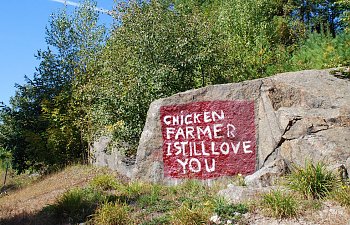
For more about this story go to (copy and paste link - does't seem to be a live link in BYC):
https://www.nhpr.org/post/you-asked-we-answered-whats-chicken-farmer-i-still-love-you-rock#stream/0
https://www.nhpr.org/post/you-asked-we-answered-whats-chicken-farmer-i-still-love-you-rock#stream/0
My research findings:
My Coop rules:
· Climate specific: can handle high winds (70mph+) and heavy snow load. Our climate gives somewhere between 6’ & 10’ of snow each winter, and usually a week or two below 0 degrees (F) – sometimes as low a -25, with wind chills of -20 to -50. We live on an exposed ridge – so most of our snow gets blown off the ridge.
This is the Tip Top House: a manned weather station atop Mount Washington. Note the chains over the roof. The White Mtns have a unique microclimate that creates some of the most volatile weather on the planet. The weather station still holds the record for the highest wind speed ever recorded by a manned weather station: 231 MPH (picture taken from the Mount Washington Observatory website)
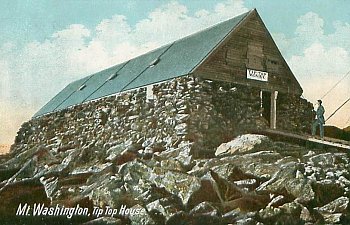
· 4[ft] per chicken.
· Roosting space of 1 linear foot/ chicken, with 1 ft. clearance to walls and other roosts.
· 2x4 roosting bar, wide side up – apparently, this is better in cold weather, as the chickens feet don’t need to wrap around – allowing their underside to sit atop their feet, insulating them from frostbite.
· 1 nest box / 4 chickens.
· Food and water available inside in winter
· Lighting to work inside and extend laying season if desired, although this is a point that is not agreed upon on BYC
· Ventilation to allow humidity from chicken waste and breath
· No drafts on roosting chickens
· Waterproof (a dry chicken can handle NH’s cold, snowy winters)
· Protection from local predators (see below)
Run rules:
· The run’s purpose is predator protection – keeping predators from getting access to your flock when they are outside the coop.
· 10 [ft] / chicken
· Protect from local predators: Mink, Ermine, Long Tailed Weasel, Fisher (Fisher-cat in NH, even the name of our AA minor league baseball team), Owls, Hawks, Bald Eagle, Black snake. Then the big guns – all pictures were taken on our land, within 500 yards from the coop location:
Black bear:
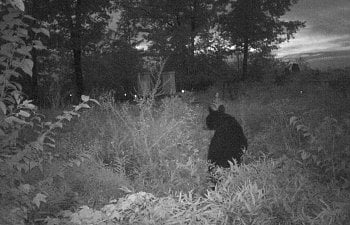
Bobcat:
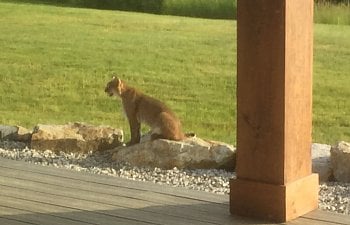
Coyote:
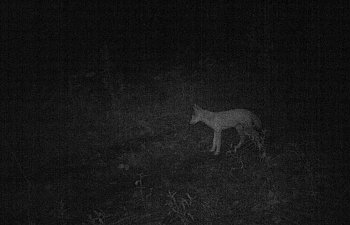
· ½” hardware cloth on the sides, top and either buried 1 ft. or a 2 ft. skirt around the entire coop to discourage digging predators.
· Water and food accessible during the day. At night, the ½” hardware cloth will keep out rodents- but black bear love bird feeders, and chicken feed – and can easily get through hardware cloth. For this reason, given bear in the area – electric fencing is recommended.
Predator Deterrence:
Electric Fencing creates a psychological deterrent. It does not provide a physical deterrent. Though I’m new to chickens, I’ve kept honeybees for several years. Bear love insect larvae – and a beehive has thousands of baby bees. Unlike poo bear – real bears like honey – but they love bugs. There is a lot more protein in the bees and larvae. I use electric netting to prevent smaller animals from getting to the beehives. More experienced beekeepers taught me that the key to deterring black bear is to actually draw them to the fence, and bait the fence to give them a shock. I use bacon tied to the netting. The bear (and my dogs) touch the bacon (and wire) with their nose or tongue - and never come back.
Electric netting does nothing to stop moose. This young female walked right through our bee yard ignoring the shock, and dragged the netting a few hundred yards. We decided to drop some trees along the game trail she used, making her take a different path. Our coop is in the same location as the beehives – so far, she hasn’t returned to this spot!
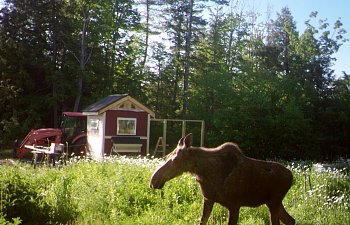
Newbie Mistakes: What I’d do differently: Coop planning, construction and chicken math.
I’m no expert – not even close. I’m 6 months in as a flock owner and I’m learning so much from the BYC crowd. Mostly – I’ve learned what I’d do differently.
I decided to get chickens about a year ago. I wanted to eat clean food – not industrial agro produced. I wanted eggs and meat. I researched everything I could via the Internet. I read blogs, news articles, homesteader and prepper websites, YouTube videos, and of course, Google brought me to BYC.
I spoke with my brother-in-law who annually raises a cow, pig, turkey and meat chickens. I looked at his coop and barn set up; Not something I could replicate- He lives on farmland that’s been in his family 300 years, while we are carving a homestead out of second growth forest and atop a mountain ridge.
So – should I have just asked him to raise another 20 chickens for me???
Nope – I wanted to DIY it. With no building experience, I learned framing on YouTube, and lay out my coop build based on material I already had on hand so I could build it as inexpensively as possible. I found windows at the dump.
The first big decision: where to get chicks, and what type. Breeders seemed concerned with appearance, and were much more expensive. I was going for function over form – eggs and meat, not appearance. Google google google… and I chose Meyer hatchery. I asked their advice on breeds. They need to be cold hardy – smaller comb and waddles. As I’m experimenting this first year – I decided to go for a variety. I wanted dual-purpose birds. So 3 hybrid Golden Buff (red sex link), 3 Buff Orpingtons, 3 New Hampshire reds, and 4 Barred Rocks. Ordered for late April delivery.
First mistake #1: I ordered chicks before having the coop finished. I gave myself 5 months. I started construction in the basement – framing the floor, sides, and roof trusses. I decided on 6’x8’= 48 [ft], or 4 [ft] per chicken. it was a mad dash to finish thanks to a very wet spring (NH has 5 seasons :Fall, Winter, Mud, Bug and summer)
Mistake #2: I should have gone bigger – 4 [ft]. is a minimum. Instead of 8x6, I should have gone 8’x10’ to permit roosting bars on 3 sides, 1’ from the wall, and a 2’ poop board under each. That would allow me a 4’ x 8’ area to stand in to clean poop boards and more room for the chickens when cold hits, wind blows and snow flies, and they don’t want to go outside.
It rained all of spring. I couldn’t pour the footings for the coop’s corners. We went from frozen solid to a muddy thaw. The chicks arrived before I started to assemble the pieces I built inside during winter. (See mistake #1 again), 4:30 a.m. the post office called to say that the chicks arrived in the mail – all healthy! They went in the brooder the same day I poured the footings. I now had a deadline. The chicks would outgrow the brooder in 6 weeks. The pressure was on.
Fortunately, the weather improved and I got the “too small coop” finished just as daytime temps got to about 70 and the chicks had feathers. Into the coop they went. The pop door was not open, as I hadn’t built a predator proof run yet. That gave me a week to finish the run before they’d be leaving the coop. Finished just in time. The run is 8’x15’ = 120 sqft. 10 sqft/chicken, plus and additional 48[ft] underneath the coop which is elevated 2’ above the ground.
Mistake #3. 10 sqft is a minimum per chicken in the run. I could have and should have gone bigger. If you are planning on keeping them in the run, and not allowing them to range, plan on more than 10 sqft/chicken. If space is constrained – get fewer chickens.
In summary, I’d change the following:
1) Determine the size of your flock, assume you’ll love it, and get more chickens, and build to handle your future flock size – and start with more than 4[ft]/ chicken.
2) Build your coop for function first. Design from ground up.
· Pop door on the floor.
· Nest boxes just above the floor
· 2’ Poop boards around the perimeter on 3 sides, above the pop door and nest box.
· 2”x4” Roosting bars above the poop boards. Easy clean up and the 2”x4” is better in cold weather – allowing the chicken to easily cover her feet with her feathered body.
· Windows approx. 18” above the roosting bars. That way- air circulated above the chickens, not directly on them. I modified my coop on recommendations from BYC experts – I can raise the roost and poop boards to window height for hot summer nights, and drop them down out of the draft when the weather turns colder.
· In summary – my next coop will allow 18” for the pop door and nest boxes, plus 18” for poop boards and roosting bars. Windows start at least 36” above the floor.
3) If you aren’t going to allow your chickens to range – build a run larger than 10 [ft] per chicken. To me – just standing in the run with the chickens around me, it is cramped. I’m not a visual person. I should have stood in a room in our house that’s close to 8’x15’ and visualized having my dozen chickens in the room. I recommend taping out the space somewhere. If you are limited in space because of neighbors, setback requirements – get fewer chickens.
4) But – if you have space – plan ahead. You should build in anticipation of chicken math. You are likely to add chickens.
Mistake #4: Dual purpose chickens a very different than meat birds. As my original goal was for healthy, home grown eggs and meat, the dual purpose chickens doesn’t provide nearly as much meat as I expected. Basically – to feed our empty nest, just 2 of us, we need an entire chicken: breasts, wings, legs, and thighs. The carcass became a great broth and soup – but basically, the dual purpose birds provided 2 meals for 2 people. Next year, we’ll try Cornish cross and rangers, and possibly American Bresse. Long term, I hope to create a self sustaining supply of meat chickens. But I need much more experience before then – moving from Newbie to Novice.
Please let me know what you think, and where you disagree. This is a learning process for me. Your insight had been incredibly valuable in my journey as a chicken owner.


Thanks for reading!